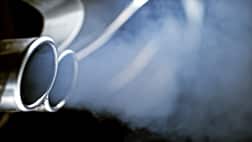The quality of air in Chicago has improved in many significant ways over the past several decades. Unleaded gasoline and catalytic converters have significantly reduced emissions from our autos and industrial emissions are under better control.
We still have a long way to go, as anyone who takes a walk in the central part of our city on a steamy, stinking Summer day will testify, but the overall appearance and quality of our air is better than it was in the days where many buildings were heated by coal burning furnaces and factory chimneys belched whatever they pleased into the sky.
A Not So Silent Killer Is Largely Unrecognized
Perhaps you feel virtuous on your walk from the train to your office in the city. After all, you are getting exercise built in to your daily routine, so much better than when you used to sit in your car moving at not much better than a walking pace in the so called express lanes.
You walk down the lightly trafficked early morning street past the delivery trucks that are idling curbside. One of the trucks grinds its way forward and you are engulfed in a cloud of diesel exhaust. “Oh well”, you mutter, “it’s probably not that bad”.
Actually It Really Is Quite Bad For You
Despite the progress in removing some of the most toxic elements from automobile exhaust, virtually nothing has been done about diesel exhaust. This is significant because diesel exhaust contains a toxic brew of chemicals that are extremely harmful to anything with a set of lungs, far worse than what drifts from our cars.
Diesel engines emit a much higher concentration of fine particles (aka soot) than gasoline engines. OSHA REF These particles, often referred to as diesel particular matter (DPM) are essentially solid carbon with a variety of potentially toxic organic compounds stuck on their surface. These include cancer-causing substances such as benzene, arsenic, and formaldehyde CALIFORNIA REF A number of scientific studies suggest that when diesel particle levels in the air are increased, there is a corresponding increase in hospital admissions, emergency room visits, asthma attacks, and premature deaths. The elderly and young children are particularly vulnerable.
Those who are ecologically conscious may have a hard time escaping the effects of diesel exhaust. If you cycle to work along a street that has high concentration of diesel exhaust particularly at a vigorous speed, you are drawing diesel particles deep into the lungs. CYCLING REF The Chicago Tribune recently produced an enlightening series of articles that documented high concentration of diesel particles that exist in commuter stations. It is my understanding that in response to these articles Metra has taken steps to improve the exhaust systems in the main downtown train terminals.
Guess Who May Be Most At Risk?
I rarely rode a school bus except to go to track and cross-country meets in high school and I don’t attach much emotion to school buses. I am probably an outlier in this regard. Many of my friends tell me they have strong visceral responses at the sight of the familiar yellow (vehicles) usually engendered by an emotional experience imprinted forever in the malleable and retentive clay of the grade school mind.
Sometimes the emotional imprint is positive, a first kiss. More often there is a negative emotional tint, a gang of bullies who strong arm you for your lunch money or a group of girls who refuse to admit you to their space. No doubt you have largely recovered from these minor traumas, but you may have suffered a more serious damage of which until now you are blissfully unaware.
The school bus that sat idling outside your school accumulated an intense mixture of toxic materials, which you breathed into your body when you jumped on board. Some traditions are slow to disappear. The school bus that picks up your own children may very well be powered by a diesel engine that blows its poison exhaust under the bus, where it can seep into the passenger area.
This is of particular significance to school age children, with their rapidly growing nervous systems. It is probably true that kids are more vulnerable to the effects of harmful substances than are adults. SAVEREGION REF
Three Things You Can Do To Protect Yourself And Your Children
Make sure diesel exhaust fumes are not finding their way into your home or office. This is particularly true in the city, where the intake vents for the ventilation system may be at street level in an area where trucks rest with their engines idling. Signs should be posted that restrict parking and require trucks to turn their engines off. If you live or work in a larger building that has doormen or engineers make sure they keep a lookout for diesel trucks idling near the intake vents and insist they move on.
If you have children make sure their school buses are well ventilated. If at all possible the exhaust should not discharge beneath the passenger compartment. Above all, school buses should not idle for long periods before they pick up children.
If you are walking in congested areas try to pick a route with less diesel truck traffic. In an ideal world there would be functional maps that track exhaust pollution along popular routes for walkers. One of my favorite paths for people who walk from one of the commuter train terminals to North Michigan Avenue involves the north side of the Chicago River. There is a vehicle free pathway from LaSalle Street to Michigan Avenue that provides magnificent views and protection from exhaust.
Is There A Silver Lining?
Economic forces may work to our benefit and reduce the number of diesel trucks in the coming years. The abundance of relatively inexpensive natural gas has emerged as a game changer in a number of ways. The United States wil soon emerge as a major energy exporter. We will also transition away from diesel to natural gas as a source of power for trucks and transportation vehicles. There will also be applications of electrical engines and even potentially hydrogen engines in the future. When this happens we will all be able to breathe a little easier.
Cecily Supan, B.A. contributed research to this article



